
Melton Constable Railway Works
Encyclopedia
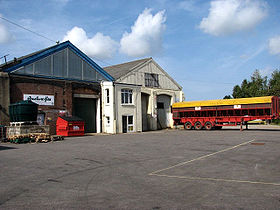
Melton Constable
Melton Constable is a village and civil parish in the English county of Norfolk.It covers an area of and had a population of 518 in 225 households as of the 2001 census.For the purposes of local government, it falls within the district of North Norfolk...
from 1883 to 1964 were vital to the village economy and indeed it is known that the village itself was created to house the employees who worked there. The works are known by many as the 'Crewe of North Norfolk
North Norfolk
North Norfolk is a local government district in Norfolk, United Kingdom. Its council is based in Cromer. The council headquarters can be found approximately out of the town of Cromer on the Holt Road.-History:...
' as Crewe was similar to Melton Constable, although on a much larger scale. Since the loss of the works and rail links the village has never recovered to pre World War I levels.
Opening
The first rail presence at the site was in January 1882 when the Lynn & Fakenham Railway began services to Kings Lynn. Later in the year, the line to North Walsham was opened (linking Kings Lynn with Great Yarmouth). William Marriot noted in his reminiscences that he had given up on the thought of going to AmericaUnited States
The United States of America is a federal constitutional republic comprising fifty states and a federal district...
because he was offered a permanent post and salary to stay with the contractors Messrs Wilkinson & Jarvis. William first visited the works when the foundations had been laid. He also noted the framework for the houses in Melton Street were up. In December 1882 the Norwich
Norwich
Norwich is a city in England. It is the regional administrative centre and county town of Norfolk. During the 11th century, Norwich was the largest city in England after London, and one of the most important places in the kingdom...
line was opened. The growth of this new network was rapid. The buildings are known to have opened in 1883. As a result, the works grew to employ over 1000 people and the village population grew from 118 in 1881 to 1,157 in 1911.
The smaller railway companies combined to form the Eastern and Midlands railway in 1883. Later the line to Cromer Beach opened in 1887. The result was that Melton Constable, a small village that began as a parish with 19 houses, became a junction of four new railways lines connecting Norfolk, Lincolnshire and Cambridgeshire. The facilities grew to cover 14 acres (56,656 m²) that were once farmland. The site included an erecting shop along with this two long 'workshops'. There was an iron foundry, gasworks for the village, drawing offices and accommodation. The site was also served by a small miniature railway like the one at Horwich and Crewe.
The Midland and Great Northern Joint Railway
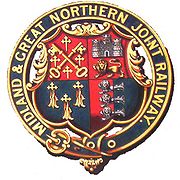
Melton Constable railway station
Melton Constable was a railway station on the Midland and Great Northern Railway which served the North Norfolk village of Melton Constable from 1882 to 1964...
. Activities carried out included maintenance of rolling stock and locomotives, however 19 locomotives were constructed there and many wagons were too. The Midland Railway
Midland Railway
The Midland Railway was a railway company in the United Kingdom from 1844 to 1922, when it became part of the London, Midland and Scottish Railway....
and the Great Northern Railway
Great Northern Railway (Great Britain)
The Great Northern Railway was a British railway company established by the Great Northern Railway Act of 1846. On 1 January 1923 the company lost its identity as a constituent of the newly formed London and North Eastern Railway....
were the shareholders in the joint railway. The GNR looked after the track and buildings, while the MR sorted locomotives and rolling stock. This resulted in maintenance of the 'hand me downs' as main activity. This old rolling stock would have had repairs and renovations in the Melton shops. The concrete production is the most famous export from Melton Constable. Many concrete items of railway furniture and even station buildings were made at the concrete division there.
Another role was the cutting up of old locomotives. Often the old types of engine were gas axed near the foundry.
The plant and stores were used in both world wars and attacked in both world wars.
LNER ownership
In 1923-4 the M&GN was passed over to the London and North Eastern RailwayLondon and North Eastern Railway
The London and North Eastern Railway was the second-largest of the "Big Four" railway companies created by the Railways Act 1921 in Britain...
and the London, Midland and Scottish Railway
London, Midland and Scottish Railway
The London Midland and Scottish Railway was a British railway company. It was formed on 1 January 1923 under the Railways Act of 1921, which required the grouping of over 120 separate railway companies into just four...
(LMS). The LNER had taken over the GNR and the LMS the Midland part. At one time, the LMS was the biggest commercial operation in the Empire and second largest employer in Britain. Operation was as before with the M&GN remaining much like the M&GN had always run since 1924. However in 1936 the LNER wholly took ownership of the M&GN system, and closed the works as the LNER had major works at Doncaster and Stratford which contained more modern machines and skills, so the amount of work the plant did was vastly decreased. Employees were relocated to Stratford
Stratford, London
Stratford is a place in the London Borough of Newham, England. It is located east northeast of Charing Cross and is one of the major centres identified in the London Plan. It was historically an agrarian settlement in the ancient parish of West Ham, which transformed into an industrial suburb...
and Doncaster
Doncaster
Doncaster is a town in South Yorkshire, England, and the principal settlement of the Metropolitan Borough of Doncaster. The town is about from Sheffield and is popularly referred to as "Donny"...
. The village never recovered from the economic disaster, as the works was the major employer. However, the works did not close completely and visually change little, with simple repairs still being conducted there.
British Railways
The main work for the rest of its life was wagon sheet production. This carried on right up into ownership by British Railways. This ownership take over was on 1 January 1948. At first, BR was kind to the works. A new engine shed was built in 1951 on the site of the wooden one. This building could hold 12 engines. Like any other railway motive power depotMotive power depot
Motive power depot, usually abbreviated to MPD, is a name given to places where locomotives are stored when not being used, and also repaired and maintained. They were originally known as "running sheds", "engine sheds", or, for short, just sheds. Facilities are provided for refuelling and...
or works site, Melton Constable used stationary boilers to raise steam needed for machinery. It was noted that old J15 locomotives were used for this duty. In the late 1950s most of the former M&GN was closed and lifted, the line from Sheringham to Melton Constable surviving until the Beeching Axe
Beeching Axe
The Beeching Axe or the Beeching Cuts are informal names for the British Government's attempt in the 1960s to reduce the cost of running British Railways, the nationalised railway system in the United Kingdom. The name is that of the main author of The Reshaping of British Railways, Dr Richard...
of 1964. This is when the works closed completely to railway work. The station was demolished in the 1970s along with the turntable. The main buildings were converted to an industrial estate.
The World Wars

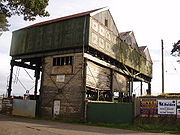
World War I
World War I , which was predominantly called the World War or the Great War from its occurrence until 1939, and the First World War or World War I thereafter, was a major war centred in Europe that began on 28 July 1914 and lasted until 11 November 1918...
was declared and along with other railway works Melton was required to contribute to the war effort. There was increased maintenance due to extra use of the track and rolling stock, also the shops where put into shell production (30000 HE9 of shell noses and thousands of base rectification plates). William Marriott (Chief Engineer and manager of the M&GN) noted that troop traffic was heavy and in some instances over 20 trains went through Melton Constable in one day.
As the railway was in M&GN ownership it was agreed that Melton would do the maintenance for the parent companies while their workshops did more war work. This was because of the better machines, skills and capacity.
Marriot noted repairing 70 Midland Railway locomotives and building 14 rail wagons, 30 ballast wagons, 30 goods vehicles on top of repairing 500 ordinary wagons for the GNR.
Other work included producing light railway turnouts.
The war also meant Melton Constable becoming a German
Germany
Germany , officially the Federal Republic of Germany , is a federal parliamentary republic in Europe. The country consists of 16 states while the capital and largest city is Berlin. Germany covers an area of 357,021 km2 and has a largely temperate seasonal climate...
target. The production often went well into the night, resulting in them being well lit. Vast sums were spent on roof blinds to protect from Zeppelin
Zeppelin
A Zeppelin is a type of rigid airship pioneered by the German Count Ferdinand von Zeppelin in the early 20th century. It was based on designs he had outlined in 1874 and detailed in 1893. His plans were reviewed by committee in 1894 and patented in the United States on 14 March 1899...
raids. The water tower at the back of the site has repair work from damage caused from bombs that hit the area. There would often be raids three nights running as in 1915 East Anglia was hit badly. Damage was done in Sheringham
Sheringham
Sheringham is a seaside town in Norfolk, England, west of Cromer.The motto of the town, granted in 1953 to the Sheringham Urban District Council, is Mare Ditat Pinusque Decorat, Latin for "The sea enriches and the pine adorns"....
and Great Yarmouth
Great Yarmouth
Great Yarmouth, often known to locals as Yarmouth, is a coastal town in Norfolk, England. It is at the mouth of the River Yare, east of Norwich.It has been a seaside resort since 1760, and is the gateway from the Norfolk Broads to the sea...
.
The war also affected Marriott himself; he lost his youngest son (of 3) along with some M&GN drivers.
The Second World War was from 1939 to 1945, so most of the importance has dropped. There probably would have been an increase in wagon sheet production. It is thought that there is also damage again on the water tower at the back of the site.
Locomotive repair and production
19 locomotiveLocomotive
A locomotive is a railway vehicle that provides the motive power for a train. The word originates from the Latin loco – "from a place", ablative of locus, "place" + Medieval Latin motivus, "causing motion", and is a shortened form of the term locomotive engine, first used in the early 19th...
s were built at Melton Constable; nine were 0-6-0
0-6-0
Under the Whyte notation for the classification of steam locomotives, 0-6-0 represents the wheel arrangement of no leading wheels, six powered and coupled driving wheels on three axles, and no trailing wheels...
Ts. Some were William Marriot's design. The biggest work was locomotive repair. Overhauls, reboilering and modifications were carried out in the erecting shop on site, components being made at the iron works and machine shops. None of the locomotives built there survive into preservation although an M&GN C class (Belpaire firebox) boiler survives.
Concrete production
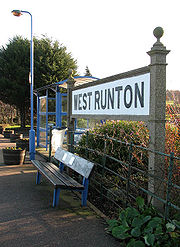
Concrete
Concrete is a composite construction material, composed of cement and other cementitious materials such as fly ash and slag cement, aggregate , water and chemical admixtures.The word concrete comes from the Latin word...
was probably his biggest lasting legacy to the modern world.
Melton manufactured ferro-concrete fence posts, then from 1915, signal posts. During World War I, Marriott was asked by the Government to develop building blocks for postwar housing (as there has been bombing). Although concrete had been used before on the railways, William mass produced it and made everything out of concrete. There were many patents produced relating to developments in concrete sleeper
Concrete sleeper
A concrete sleeper is a railroad tie made out of steel reinforced concrete.-History:Concrete sleepers were first made in Germany in 1906 for use between Nuremberg and Bamberg.-Types:...
s, chairs and signal posts. When the original Holt station burnt down, Melton concrete works produced a new concrete station. Today there are still many examples of the concrete products, including the lamp posts at Sheringham station on the North Norfolk Railway
North Norfolk Railway
The North Norfolk Railway – also known as the "Poppy Line" – is a heritage steam railway in Norfolk, England, running between the coastal town of Sheringham and Holt, It cuts through the countryside to the east of Weybourne with views of its windmill and passes through the well preserved country...
and the station sign at West Runton railway station
West Runton railway station
West Runton railway station is a railway station in the village of West Runton in the English county of Norfolk. The station is served by local services operated by National Express East Anglia on the Bittern Line from Norwich to Cromer and Sheringham....
. Cromer signal box
Signal box
On a rail transport system, signalling control is the process by which control is exercised over train movements by way of railway signals and block systems to ensure that trains operate safely, over the correct route and to the proper timetable...
base is made of Melton concrete. After 1916, the M&GN used the concrete blocks for box construction, however only Cromer Beach was built to this design. Gedney railway station
Gedney railway station
Gedney railway station was a station in Gedney, Lincolnshire. It was a station on the Midland and Great Northern Joint Railway network. It was closed in 1959.The station survives today but in a derelict state.Former Services-External links:...
sign is a Melton product. The only surviving M&GN signal in original position is Melton concrete (outside the village of Sheringham).
Also all the concrete products today have some ancestry in the works.
The site now
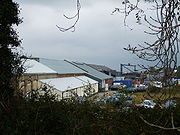
Potato
The potato is a starchy, tuberous crop from the perennial Solanum tuberosum of the Solanaceae family . The word potato may refer to the plant itself as well as the edible tuber. In the region of the Andes, there are some other closely related cultivated potato species...
storage. The yard near the water tower is used for storage. To the south of the buildings, the site of the South Junction is now industrial buildings. The gasworks have been demolished. The 1951 engine shed survives in use. The goods shed, although not connected to the works, survives. Many of the buildings have been re-roofed with modern roofs of metal and not tiles. Also, the chimneys have been demolished, one next to the engine shed as recently as the 1990s.
Listing and protection
The water tower is in the process of being listed for protection. The roof has been replaced to increase its life. The village of Melton Constable has been placed under a protection order to prevent any unnecessary change and preserve the railway village. Land next to the works site has been bought by the village for village use. A Melton Constable concrete works product that is Cromer Beach signal box (the base blocks) is now grade II listed and a working museum.Rolling stock
It is not known if any rolling stock products survive but there are some items that could have been serviced there. M&GN 129 (restored) and M&GN 3 (under restoration) could have visited the works when they were in use. Also two M&GN brake vans, number 23 (private site) and number 12 (under restoration). It is known that number 12 was part of the Melton Constable breakdown train. There are many Midland Railway and GNR coaches left that could have been serviced there during the War.Employees
Today there are few employees of the works themselves, however in 2000 the Midland and Great Northern Joint Railway Society produced an oral record of former employees. There are still many people in the village and surrounding villages who remember the railway pre Beeching and pre BR cuts. Plus it is hard to find anyone who does not have a relative who used to work on the M&GN or knows someone who did. William Marriott also has living relatives today.50th Anniversary celebrations
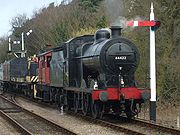
Leicester
Leicester is a city and unitary authority in the East Midlands of England, and the county town of Leicestershire. The city lies on the River Soar and at the edge of the National Forest...
from 1935-1940. 4F locomotives were once common on the M&GN.
See also
- Derby Carriage and Wagon WorksDerby Carriage and Wagon WorksDerby Carriage and Wagon Works was built by the Midland Railway in Derby, England. The plant has been through many changes of ownership and is currently owned by Bombardier Transportation, a subsidiary of Bombardier Inc. of Canada. As of 2011 it is the only remaining passenger rolling stock...
- Crewe WorksCrewe WorksCrewe railway works is a British railway engineering facility built in 1840 by the Grand Junction Railway. It is located in the town of Crewe, in the county of Cheshire....
- Doncaster WorksDoncaster WorksDoncaster railway works is in the town of Doncaster, South Yorkshire, England.Always referred to as "the Plant", it was established by the Great Northern Railway in 1853, replacing the previous works in Boston and Peterborough...
- Midland RailwayMidland RailwayThe Midland Railway was a railway company in the United Kingdom from 1844 to 1922, when it became part of the London, Midland and Scottish Railway....
- Rolling stockRolling stockRolling stock comprises all the vehicles that move on a railway. It usually includes both powered and unpowered vehicles, for example locomotives, railroad cars, coaches and wagons...
- Great Northern RailwayGreat Northern Railway (Great Britain)The Great Northern Railway was a British railway company established by the Great Northern Railway Act of 1846. On 1 January 1923 the company lost its identity as a constituent of the newly formed London and North Eastern Railway....
- Stratford WorksStratford WorksStratford Works was the locomotive-building works of the Great Eastern Railway situated at Stratford, London, England. It was opened in 1847-1848 by the GER's predecessor, the Eastern Counties Railway...
- List of railway companies involved in the 1923 grouping
- Horwich WorksHorwich WorksHorwich Works was a railway works built in 1886 by the Lancashire and Yorkshire Railway in Horwich, near Bolton, in the North West of England when the company moved from its original works at Miles Platting, Manchester.-Buildings:...
- William Marriott
Further reading
(a small selection of available literature)- "Railway World Special - The M&GN", M.J.Clark (Ian Allan)
- "Scenes from the M&GN", R.H.Clark (Moorland)
- "A Short History of the M&GN Joint Railway", R.H.Clark (Goose & Son)
- "A Guide to the Midland & Great Northern Joint Railway", Nigel J.L.Digby (Ian Allan)
- "The Liveries of the M&GN", Nigel J.L.Digby (M&GN Circle)
- "The Locomotives of the M&GN", A.M.Wells (HMRS)
- "Running a Norfolk Railway", A.C.Whitaker (M&GN Circle)
- "Operation Norfolk: Midland & Great Northern Joint Railway Passenger Services 1954", E.Wilkinson (Xpress Publishing)
- "The M&GN Joint Railway", A.J.Wrottesley (David & Charles)

